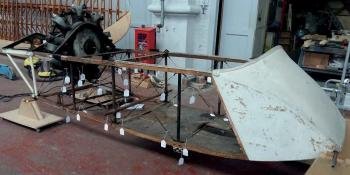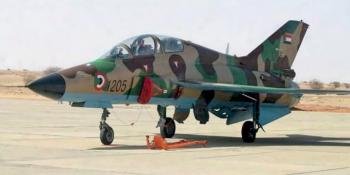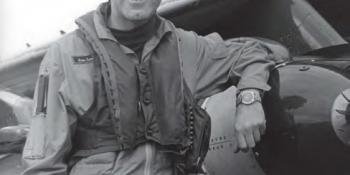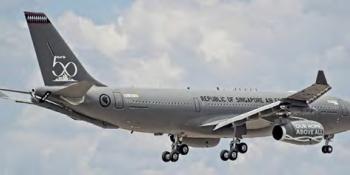Roberto Yáñez and Alex Rodríguez report on NATO’s prestigious Tactical Leadership Programme, which recently celebrated its 40th anniversary
MILITARY NATO TACTICAL LEADERSHIP PROGRAMME AT 40

Los Llanos Air Base is located to the south of the city of Albacete; the largest city in the Castilla La Mancha region of central Spain. Home to the Ejército del Aire’s Eurofighterequipped Ala 14 (14th Wing), Los Llanos Air Base is also home of NATO’s Tactical Leadership Programme and its busy flying courses each involving aircraft and helicopters from around Europe. AIR International begins its story with an explanation of how the annual series of TLP courses are devised.
Organising a course
After being notified by each of the programme’s participant nations’ training requirements at the end of 2017, the TLP Staffdeveloped the calendar for 2018. This year will see a rise in the academic courses to 12: four composite air operations (COMAO), two electronic warfare (EW), two intelligence, two support and two combat search and rescue (CSAR). The number of flying courses will remain at the four that are planned annually. The first academic course of the year was an eight-day class devoted to the planning and execution of COMAO missions. Once this course was over, intense preparations began to welcome personnel and material for the first flying course of 2018. This complicated logistics operation is the responsibility of the small Spanish contingent of the TLP Support branch. Once again, it has been responsible for coordinating the needs of each participant country with regards to the reception of equipment and personnel and working with the different Ejército del Aire (Spanish Air Force) units that support the staged arrival of units. The week before the course begins, ground convoys and transport aircraft arrive at Albacete with support equipment for air operations, along with the majority of the 638 military personnel involved.
The first two days of the course were devoted as usual to academic activities, in which the pilots received all the necessary information to operate safely in the training airspace. At the same time, there were several meetings in which the participants worked out the various common tactics and methods to be used to undertake the planned missions.
Flying course 2018-01
The nations acting as Blue Air during flying course FC 2018-01 had a total of 22 aircraft at their disposal, while Opposing Forces (OPFOR, or Red Air) was made up of eight aircraft. The course was also supported by a complex EW and anti-aircraft artillery simulation system provided by the Multinational Electronic Warfare Tactics Facility Polygone. It was charged with replicating anti-aircraft artillery and air-tosurface missiles emplacements, providing jamming and other threat mechanisms the pilots needed to face to undertake their assigned missions. There was also participation from other aircraft supporting the exercise, such as three helicopters that took part in two scheduled CSAR missions. A Learjet from GFD GmbH undertook radar and communication jamming missions, a maritime patrol aircraft from the Ejército del Aire and a F100-Class frigate from the Spanish Armada supported naval operations. A Royal Air Force Sentry AEW1 participated during the first part of the course and an Aeronautica Militare Gulfstream G550 Conformal Airborne Early Warning (CAEW) covered the second half.

Objectives
The fundamental objective of the TLP is to provide the participants with a series of experiences that will help them with their ability to organise and lead multinational missions with large numbers of participating aircraft. To exercise these skills for FC 201 8- 01, the TLP instructors scheduled 15 flying missions of different types and complexity levels, with increasing threat levels while taking into account the level of ability demonstrated by the course participants. In this way, the pilots who graduate as mission commander have been exposed to levels of stress and pressure equal to real missions. Furthermore, this stress is increased by having to undertake mission planning in a muchreduced timeframe than is normal.
In order to achieve quality training for the pilots, there needs to be a credible threat at all times to provide a constant challenge to the aircrews. To support this, the TLP has an operations room that receives all data from a mission in real time, including the position of the aircraft at all times, thanks to GPS systems carried by each pilot. In this way, the instructors can activate the appropriate threats as the Blue packages pass by. The pilots must then react appropriately to the given threat.
Colonel Luis Villar, TLP Commander, said: “If the pilots are less advanced, the level of pressure is lowered; if they are able to deal with situations with ease, the level of difficulty is raised. The pilot that is flying the mission always needs to have a challenge. They must constantly be fighting against some threat. We can complicate their mission as much as we want within the limits of their abilities, in such a way that at the end of the mission they will have encountered several different critical situations that have to be resolved inflight. It’s all about increasing the leadership abilities of each of the future mission commanders.”

The pressure on the pilots participating in the course comes not just from ground threats, but also from opposing aircraft. There are a limited number of Red Air aircraft on each course, which are regenerated at a faster or slower rate so that the Blue Air pilots can have the right level of pressure for their level of experience. Col Villar commented: “All the assets we have at our disposal are there, so that the pilots being trained can achieve the courses training objectives.”
Since mid-2016, Red Air pilots receive a diploma for graduating as OPFOR pilots after finishing the TLP course. Col Villar said: “This training as adversary pilots is very popular as of late. For this reason, procedures are being standardised and circulated among NATO forums so that any Red Air pilots can work within a set of standards to provide quality ‘enemies’ for training our pilots.” Red Air pilots conduct themselves in the same way as the pilots of the enemy aircraft as which they are masquerading. To achieve this, TLP intelligence officers brief Red Air pilots on the tactics, performance and armament of enemy aircraft. Col Villar said: “We teach them how to act as OPFOR and we give them a certificate at the end accrediting them that after a month of work they have learned the tactics that our intelligence has learnt are used by possible enemies. They can now train pilots in adversary tactics.”
The TLP can count on ground units provided by member countries, including German Roland surface-to-air missiles, Spanish Army and Norwegian Advanced surface-to-air missile system batteries or the Royal Air Force’s SAM-6. Col Villar said: “For ground units, participation in a TLP is also valuable. Although they are limited in using their real-world capabilities, these exercises provide very valuable training in teaching procedures, practice firing etc.”
Apart from the first two days of the course, which are devoted to academics, there are other days set aside for classroom instruction. On FC 2018-1, one of these additional academic days was devoted to preparing for an anti-surface warfare mission, during which participants received additional information to help in the proper planning and execution of the mission.
According to Col Villar: “We try to give the student pilots a wide range of missions to undertake. The work-load for each is scalable, although there are some very specific missions with different connotations and difficult procedures that have to be studied beforehand. One cannot just undertake a CSAR mission, for example, where there is a great interaction between various ground units, slow moving aircraft, etc, without a set of clearly predefined coordination procedures that go beyond normal dayto- day operations. The same is also true for naval missions.”

Participants in FC2018-01
Blue air Aeronavale
Two Rafale Ms
Aeronautica Militare
Two EF-2000 Eurofighters
Armée de l’Air
Four Mirage 2000Ds
Ejército del Aire
Four EF-18Ms
Elliniki Polemiki Aeroporia
Two F-16Cs
Luftwaffe
Four Eurofighters
Royal Netherlands Air Force
Four F-16AMs
Red air Aeronavale
Two Rafale Ms
Ejército del Aire
Two EF-18Ms
Two Eurofighters
Elliniki Polemiki Aeroporia
Two F-16Cs
Other participants Ejército del Aire
One P-3M Grupo 22
One AS332B 803 Escuadrón
Aeronautica Militare
One AB212ICO 21° Gruppo
One HH-101A 81° CAE
One G550CAEW 71° Gruppo
Royal Air Force
One Sentry AEW1 8 Squadron

As for command and control systems, apart from the participation from its home base in the UK of a Royal Air Force Sentry AEW1 during the first two weeks of the course, of note was the participation during the second half of the course of a Gulfstream G550 CAEW belonging to the Aeronautica Militare (Italian Air Force). This was the type’s first participation in an exercise outside Italy since it entered service. In addition to these systems, there was also the traditional participation of Spanish military air controllers belonging to the Ejército del Aire’s Grupo Central de Mando y Control (Command and Control Central Group), which oversaw controlling aircraft when there were no airborne air control systems available.
Forty years of continuous adaptation
It was a traditional that during the first course of the year it was common to undertake various night missions, but no longer. If requested by the participating nations, the TLP Staffcan still run largescale night operations of COMAO size where pilots who are already TLP graduates can practise the same missions but at night. However, strict safety measures needed to conduct night operations make the missions less realistic and take away from the learning objectives. This has led to the participating nations stopping requesting night courses, since they stray from the principal TLP mission of creating create mission commanders.


Although the format of the course has stayed more or less the same during its 40 years, the programme is regularly updated. The instructors assigned to the TLP are operational pilots back at their home units, to which they return after each course, continuing flying and maintaining proficiency. Upon returning to the TLP, any new tactics and techniques are passed on to the members of the academic and flying branches, who implement changes necessitated by events encountered on operations and devise new protocols for training new students.
Probably one of the most interesting challenges for the near future is the integration of fourth and fifth-generation fighters into the programme. The signing of the memorandum of understanding to extend the TLP in Albacete until at least 2029 will allow for new investment needed to support aircraft such as the F-35 that are entering service. For now, the TLP is waiting for security guidelines to be established to enable operation of the type from Albacete. The first F-35 is expected to take part in a TLP in around 2021.
Looking to the future, another challenge is the integration of new technologies, such as live, virtual and constructive training (LVC). LVC will make a large saving in the budgets of participating countries, since it will allow the interaction between real and simulated assets. By linking multiple flight simulators that transmit data to aircraft that are conducting real missions, it will be possible to interact between the real and virtual aircraft, creating scenarios that will be more complex yet less costly.
Out-of-region operations
Another of the new events this year will be an out-of-region (OOR) course away from Albacete, something that has not happened since the programme moved to Spain. OOR courses were a regular event when the programme was run from its previous location at Florennes, Belgium. It was the lower air traffic congestion in the areas proposed by Spain for training, plus the better weather, that led to the move to Albacete in 2009.
During these almost nine years of operations in Spain, there had not been any thought given to the possibility of organizing an OOR course. The entry into service of the first Italian F-35As last year led Italy to suggest FC 2018-5 should take place at its Amendola Air Base, home of 32° Stormo, operator of Europe’s first Lightning IIs. The chance to integrate these aircraft into a course, along with the contribution of a large number of OPFOR assets provided by the Italians, was more than sufficient reason to accept the offer.
Although this last course of the year is being held in Italy, it will be run in the same way as those held at Albacete, despite the integration of the F-35As. FC 2018-5 will be the first chance to integrate fourth and fifthgeneration aircraft in COMAO packages.



Although there are still two flying courses left before the year is over (FC 2018-2 was cancelled, because it coincided with other exercises taking place in Europe), work is already underway for the OOR course. The whole TLP staff will travel to Italy, not only the instructors, but also nearly all the support, finance and administration staff. Various site surveys have been planned to identify what needs to be deployed from Spain to complement the assets provided by Italy. At the same time, the TLP staff continue to prepare for the various planned academic courses, as well as for FC 2018-3, which will take place at Albacete between September 10 and October 5.






